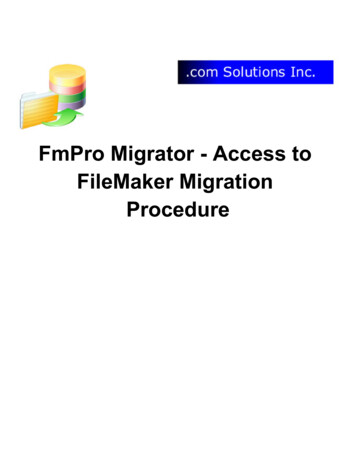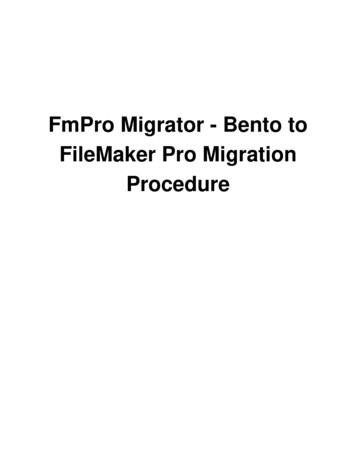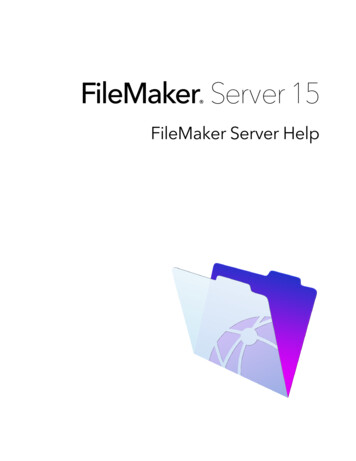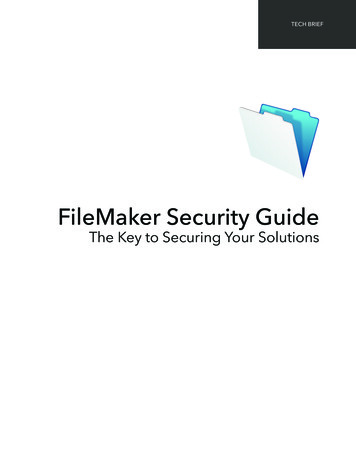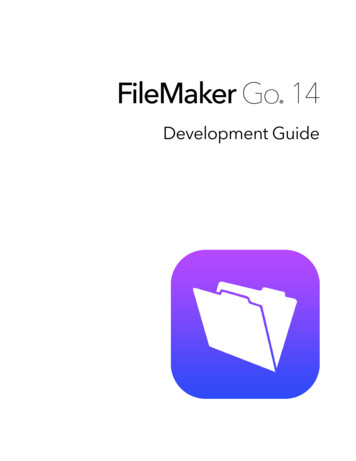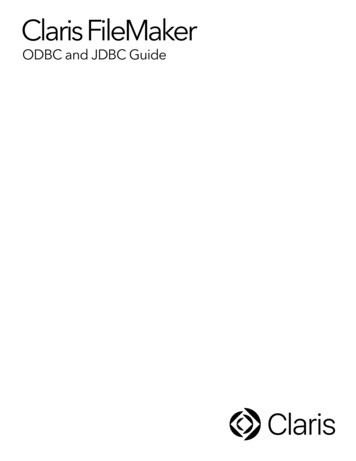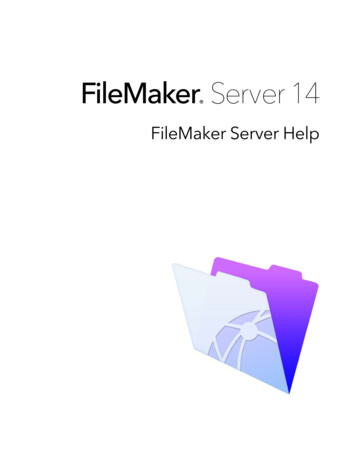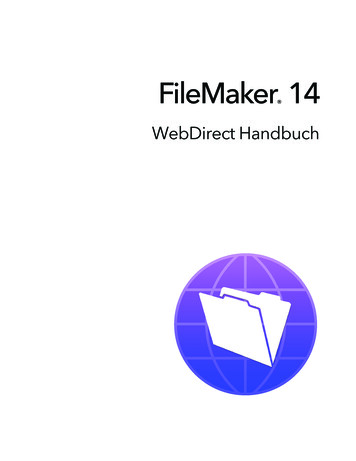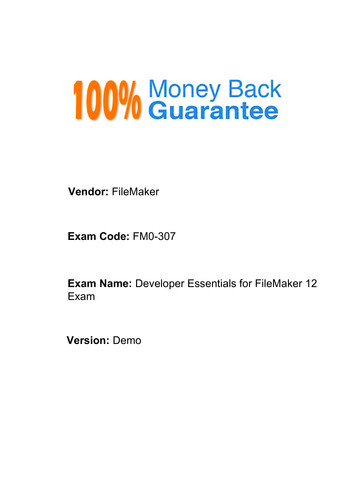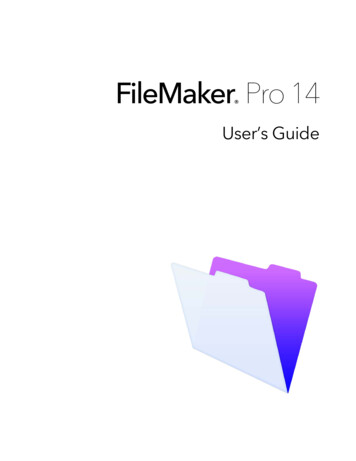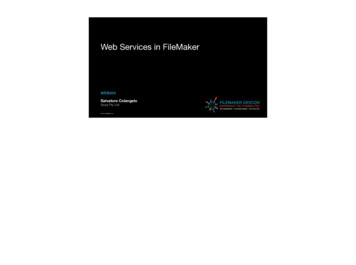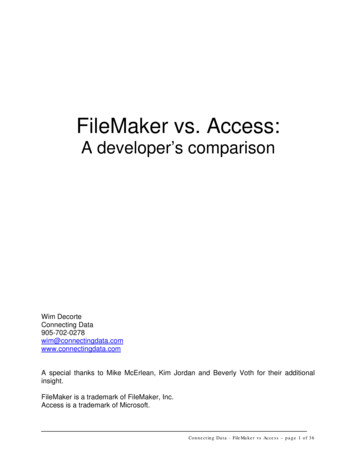
Transcription
FileMaker vs. Access:A developer’s comparisonWim DecorteConnecting ngdata.comA special thanks to Mike McErlean, Kim Jordan and Beverly Voth for their additionalinsight.FileMaker is a trademark of FileMaker, Inc.Access is a trademark of Microsoft.Connecting Data - FileMaker vs Access – page 1 of 36
Table of content1.2.3.Introduction .3The obvious .4The not so obvious .43.1.General specifications orm .123.2.3.1.What is it?.123.2.3.2.Layout design & Interface design .133.2.4.Reports .133.2.5.Data access page.143.2.6.Macros.153.2.7.Module .173.3.Relationships .193.3.1.Types of Relationships .193.3.2.What about Referential integrity? .193.3.3.ER diagrams .193.4.Event Triggers .203.4.1.Data Events .213.4.2.Error and Timing Events .213.4.3.Filter Events .213.4.4.Focus Events .223.4.5.Keyboard Events .223.4.6.Mouse Events .223.4.7.Print Events .233.4.8.Window Events .233.5.Rolling out the database .243.5.1.Multi-user .243.5.1.1.Replication – offline sharing .243.5.1.2.Peer-to-peer sharing .243.5.1.3.Client/Server Sharing .303.5.1.4.Important aspects of networking data .313.5.1.5.Web enabling.323.5.2.Security.333.5.2.1.File Password .333.5.2.2.Permissions.333.5.3.Maintenance .353.5.3.1.Renaming an object.353.5.3.2.Compacting and repairing a database.353.5.3.3.Finding duplicates .353.5.3.4.Database Documenter .354. Conclusion.36Connecting Data - FileMaker vs Access – page 2 of 36
1.IntroductionHow does MS Access compare to FileMaker? As a FileMaker developer you probably have asked thisquestion yourself or have been asked by others. The goal of this White Paper is to give you a basicunderstanding of the differences and specifics of Access and FileMaker. This comparison is specificallymeant for FileMaker developers and is entirely written from that perspective.There has been a lot of talk on the various FileMaker lists that Microsoft is dropping Access, as thisoverview will show you: that is not the case. Access is still very much part of the Office family. Luckilysince Office 95 Access is not included by default in the standard MS Office version so working with eitherAccess or FileMaker is now a more deliberate decision.We will first talk about the building blocks that are available: Files Fields Layouts Scripts RelationshipsThen we will discuss how you would roll-out an Access solution as opposed to a FileMaker solution: File sharing / Web enabling Security ScalabilityAnd how you would maintain that solution: Documenting Making changesFileMaker 5.5 and Access 20021 are the current releases of both products and these will be used in thiscomparison:Let’s start with the most obvious differences between FileMaker and Access.1Also called Access XP or Access 10.Connecting Data - FileMaker vs Access – page 3 of 36
2.The obviousThere are two very important obvious differences: Access is a Windows only product. If there is one Mac computer on the client’s network that needs toaccess the solution, then Access is no good. If your client is all Windows however, then an Accessdeveloper can be your competitor. FileMaker is also expanding into the Linux arena with theannounced version of FileMaker Server 5.5 for Linux. That is nothing something that Microsoft willlikely be doing. FileMaker is really a suite of products: FileMaker Pro, FileMaker Server, FileMaker Unlimited,FileMaker Mobile. This distinction will be very important when we draw our conclusions.3.The not so obviousHow does Access compare with FileMaker under the hood : what can be done, and which is better . . .3.1.General specificationsAs a general rule any solution will consist of more than one file and will have more than one user. Whatthen are the limits?Microsoft AccessFileMakerFile sizeOne file (*.mdb) cannot exceed 2 GB.However, because your database caninclude linked tables in other files, itstotal size is limited only by availablestorage capacity.2 GB per file. Here too, the only reallimitation is disk space.Number of concurrent open files (fromthe users perspective)1 visible. Access can used info fromlinked tables by loading them in memoryMax 50 at any time. Depends heavilyon working with FMS or not.Number of objects in a database32,768Part of the overall file size. See belowfor an overview of objects.Number of concurrent users25550 database or 25 guests with trade-offfor FM standard.125 files to 250 guests with FMSApplication size160 MB26 MBLet’s have a closer look at the real concurrent users/concurrent files limitations.In a FileMaker Peer to Peer scenario2 the formula for trade-off between users and guests isTotal Sockets . 254Host retains . 7Leaves. 2472Regular FileMaker Pro version hosting the files, not using FileMaker Server version.Connecting Data - FileMaker vs Access – page 4 of 36
Socket Consumed Number of files x number of users x 2 (with a maximum of 247)This gives us following real limitations (remember that number of users includes the host!).The left side of the table tells us how many files we can have open for a given number of users: one usercan have 50 files open, 3 users sharing a solution can only have 41 files open, 9 simultaneous users arelimited to 13 files, and so on.The right side of the table looks at the equation from the other side. If your solution has 50 files than only2 users can use it at the same time. 30 files can be shared by 4 concurrent users, etc.# users# files# files# 15891310121012524These limitations do not apply in a scenario where FileMaker Server is used. The only real limitation thereis the overall performance of the network, workstations and server. These factors will determine if theusers find the performance of the solution acceptable.In this aspect Access falls in-between FileMaker Pro and FileMaker Server. There are no socketslimitations as in FileMaker Pro, but it does not have the “server” capabilities of FileMaker Server either.FileMaker Server will allow you to share your solution to 250 people, Access has a theoretical max of 255users. But as we will discuss later Access in a workgroup is difficult to deploy and maintain.Connecting Data - FileMaker vs Access – page 5 of 36
3.2.Objects?Access does have a limitation on the number of objects in a file and FileMaker doesn’t. What are those‘objects’ and what do we have in FileMaker?Microsoft AccessFileMakerObjects“Objects”TablesVery similar to the Table view ofa layout showing all fieldsQueriesCriteria for finds & found setsFormsLayoutsReportsLayouts with summariesData Access PagesLayoutsMacrosScriptsModulesscripts & plug-insWe’ll get into details for those objects later. Let’s talk about the different modes you can find a FileMakeror Access database in:Microsoft AccessFileMakerModesModesDatasheet viewBrowseDesignLayoutNon-existent: closest would beQuery design mode.FindPrint PreviewPreviewThe “Find” process in Access is similar to a scenario in FileMaker where you would let the user inputsearch criteria in globals, then take use those globals to perform an actual find. More about Queries later.Or more accurately Queries in Access are SQL based queries against the open database.Connecting Data - FileMaker vs Access – page 6 of 36
3.2.1. TableIn Access the Table is where you define your fields and where you could see the data as in aspreadsheet, or similar to a list mode in FileMaker.Some of the most important limitations of an Access Table:Microsoft AccessFileMakerNumber of characters in a field name6460Number of fields in a table255Unlimited.Number of open tables2048. The actual number may be lessbecause of tables open internally byMicrosoft Access.Not applicable.One Access Tablewould really be one FileMaker file.Table size1 gigabyte.size limit.FileMaker doesn’t have tables.Orrather one FileMaker file is one table.2GB.Number of characters in a record(excluding Memo and OLE Object fields)2,000Remember the 2 GB fileUnlimited.As mentioned above you would define your fields in this table. So let’s have a look at some of the fieldtypes and their specifications.Field types in red do not exist in FileMaker. Field types in Blue do not exist in Access.Microsoft AccessFileMakerUp to 255 charactersUp to approximately 64,000 letters, symbols, andnumbers used as textMemoLengthy text and numbers, such as notes ordescriptions. Up to 64,000 characters.Text fieldHyperlinkUp to 64,000 characters. Field that will storehyperlinks. A hyperlink can be a UNC path3 or aURL4Text field. You would use the Open URL script stepto activate a text string as hyperlink.Numeric data to be used for mathematicalcalculations, except calculations involving money(use Currency type). 1, 2, 4, or 8 bytes. 16 bytes forReplication ID only.Up to 255 numbers, letters, or symbols. (In mostcases, only the numbers are treated as numeric.)Number fields can't contain carriage returns.TextNumber1 byte 256 values (0-255)Only 15 significant digits will be used in calculations.2 bytes, 65.535 values4 bytes, 4 billion values 34CurrencyCurrency values. Use the Currency data type toprevent rounding off during calculations. Accurate to15 digits to the left of the decimal point and 4 digitsto the right. 8 bytesPart of the field formatting options.AutoNumberUnique sequential (incrementing by 1) or randomnumbers automatically inserted when a record isCreation optionUniversal Naming Convention, follows the format: \\serverName\shareNameUniform Resource Locator, follows the format : http:// Connecting Data - FileMaker vs Access – page 7 of 36
Microsoft AccessFileMakeradded. 4 bytes 4 billion values.BooleanDateFields that will contain only one of two values, suchas Yes/No, True/False, On/Off. 1 byte.Value list – input validation optionDates and times. 8 bytes.Dates only.Times only. A time field can contain the hours,minutes, and seconds portion of a time.TimeContainerObjects (such as Microsoft Word documents,Microsoft Excel spreadsheets, pictures, sounds, orother binary data), created in other programs usingthe OLE protocol that can be linked to or embeddedin a Microsoft Access table. Up to 1 GB.A picture, multimedia file, or OLE object (Windowsonly). You can reference container fields incalculations and summary fields. You can't find orsort records based on container fields, but you candefine text fields to describe or identify them. Then,you can find or sort records based on thedescription or identifying number in the text field.CalculationNon existent as field typeThe result of a formula that uses field values fromthe current record or related records. The result canbe one of these types of data: text, a number, date,time, or container.Part of any field definition (Validation or DefaultValue).SummaryNon existent as field typeA value that’s produced by summarizing field valuesfrom more than one record in the same file.GlobalNon existentOne value to be used in all records of the file. Aglobal field can contain text, number, date, time, orcontainer data.Creates a field that allows you to choose a valuefrom another table or from a list of values using acombo box.Option for field formattingLookupWizardAt first sight, not too much different. But defining number fields in Access is a lot more complex than inFileMaker. For instance: you really have to know how many values a certain number field type can hold.If you choose Integer for instance you field is limited to values up to the number 32,767. Very importantbecause mistakes at this point can come back and haunt you later.The absence of globals is also very significant. You can set temporary values in unbound controls, butthey are lost when the form or report is closed. Or you have to revert to Visual Basic to use solution-widevariables. Certainly not easy as a FileMaker global.As in FileMaker, there are certain options you can set while defining fields:Microsoft AccessField SizeYesInput MaskSome very interesting ones such as:FileMakerPart of the validation options, where youcan specify the maximum number ofcharacters.Phone NumberMost areneeded.notbuilt-in,workarounds(206) 555-1212Postal CodeA1B 2C3Social Insurance Number555 333 555PasswordConnecting Data - FileMaker vs Access – page 8 of 36
Microsoft AccessFileMaker*******And you can even define your custominput mask.On Layout only.Caption (label)Default ValueYes. This is where you could specify acalculation. 160 functions to choosefrom.Yes. 100 built-in functions. (Notcounting the Status functions).Validation RuleExpression builderMost frequent ones are offered as easychoices (range, unique, ). Calculatedvalidation possible.Validation TextCustomisablevalidation fails.errormessageifSame.RequiredPart of the validation rulesAllow Zero LengthPart of the validation rulesIndexedUnicode CompressionUses two bytes for each character.Allows for up to 65,536 charactersinstead of 256.No.Connecting Data - FileMaker vs Access – page 9 of 36
3.2.2. QueryIn Access, you use a query to do a find or to operate (update, add, ) on the data in your tables.With a query, you can display the records that match certain criteria, sort the data, and even combine datafrom different tables.You can edit the data displayed in a query (in most cases), and the data in the underlying table willchange.FileMaker does not make a Table/Query distinction. In FileMaker you always work with and within thetable. A query compares to setting find & sort criteria then viewing the found set.A query has much of the same specifications as a Table:Microsoft AccessFileMakerNumber of tables in a query32Compare this to doing a find usingrelated fields from other files. 50 (maxopen files).Number of fields in a record-set255UnlimitedRecord-set size1 gigabyte2 gigabyte (found set).Sort limit255 characters in one or more fields20 characters per field.Number of levels of nested queries50Number ofstatementcharactersinanSQLNumber of characters for a parameter ina parameter queryApproximately 64,000SQL statements are stored in a textfield, so 64,000 is be the max length.255You would use standard fields to ask auser input.Think of a Query as a visual user interface for building SQL statements. In fact, you can “save” your queryeither as a separate object by itself or as an SQL statement in a form or report.Connecting Data - FileMaker vs Access – page 10 of 36
A query can also bring data from separate tables together as a basis for a report a form or a data accesspage.Types of queries.There are two basic types of queries: those that merely select or summarize the data, and those thatmodify the data (called Action Queries).Select.Your basic find. Ideal for showing and updating subsets of data.Xtab .Like a pivot table in Excel.Delete .Update .like the replace functionAppend .like the import functionmake-table.creates a new table instead of merely a subset of the data. A find & exportcombined.Parameter.Some criteria are predefined, the user is prompted for other inputs (two dates, )Connecting Data - FileMaker vs Access – page 11 of 36
3.2.3. Form3.2.3.1. What is it?A Form is what FileMaker would call a Layout. Access makes a distinction between Forms and Reports(see 2.2.4 below).The biggest differences between an Access Form and a FileMaker Layout are: In Access you can use “fields” on your form that are defined nowhere else. How? All informati
2 Regular FileMaker Pro version hosting the files, not using FileMaker Server version. Connecting Data - FileMaker vs Access – page 5 of 36 Socket Consumed Number of files x number of users x 2 (with a maximum of 247) This gives
